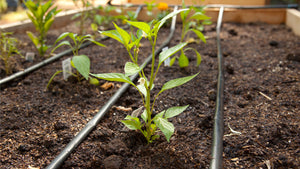Item Number: SNV8233B
Organic Pepperoncini, Italian (1 oz)
Organic Pepperoncini, Italian (1 oz)
Mild Taste and Good Pickled
- Soil Temperature: 75-85°F
- Planting Depth: ¼"
- Germination: 6-15 Days
- Height At Maturity: 24"-28"
- Days To Maturity: 62-75 Days
- Sun/Shade: Full Sun
- Spacing After Thinning: 12"
- Approx Seeds per Ounce: 5,309 Seeds
For more information, please enjoy our Resource Guide for planting and growing peppers.
Originating from southern Italy, these Italian favorites produce conical fruits reaching around 4 inches in length. They are commonly harvested green at 2 to 3 inches and are frequently pickled, though they are equally delicious when enjoyed fresh due to their thin walls and appealing pendant shape. Let's explore the key aspects of growing pepperoncini plants.
Growing Conditions
Pepperoncini plants thrive in specific environmental conditions. They require a soil temperature range of 75-85°F and should be planted at a depth of 1/4 inch. The germination period typically spans from 6 to 15 days. At maturity, these plants reach a height of 24 to 28 inches and usually require 62 to 75 days to yield peppers. Full sun exposure is essential for their growth, and after thinning, they should be spaced around 12 inches apart.
Nutritional Value
Apart from their flavor, pepperoncini peppers boast significant nutritional benefits. Sweet peppers, like these mild chili peppers, are rich in vitamins C and A. Red peppers, in particular, contain twice the amount of vitamin C and eleven times the beta carotene found in green peppers.
Cultivation Tips
Successful cultivation of pepperoncini begins with choosing a suitable location with well-draining soil and ample sunlight. Plant the seeds at the recommended depth and maintain consistent moisture levels without overwatering. Adequate spacing is crucial for healthy plant development.
Harvesting and Use
Pepperoncini peppers can be harvested when they reach 2 to 3 inches in length. Commonly used for pickling, they also provide a mild heat level ranging between 100 to 500 on the Scoville Heat Scale. Their thin walls make them ideal for stuffing or slicing into salads to add a flavorful kick.
Companion Planting and Culinary Versatility
Pepperoncini plants complement other varieties in a garden setting. They can be grown alongside bell peppers, banana peppers, golden Greek peppers, sweet Italian peppers, hot peppers, and wax peppers. In the culinary realm, they are utilized in various cuisines, from garnishing salads to becoming a staple in Mediterranean dishes.
Homemade Pickling and Substitutions
For those interested in homemade pickled pepperoncinis, harvesting at the right stage is crucial for optimal flavor. Additionally, if pepperoncini substitutions are needed in recipes, similar peppers like banana peppers or wax peppers can be used, offering a comparable mild heat level and a yellow-green color akin to the pepperoncini.
Popularity in the United States
In the United States, pepperoncini peppers have gained popularity for their taste and versatility in cooking. They are widely used, showcasing their mild heat and tangy flavor in a variety of culinary creations.
Cultivating
Cultivating pepperoncini plants involves providing optimal growing conditions, harvesting at the right stage, and enjoying their mild heat level that ranges between 100 to 500 Scoville Heat Units. Whether grown for personal consumption or as part of a diverse garden, pepperoncini peppers offer both flavor and nutritional value, enhancing various dishes and cuisines.

Check Your Zone Compatibility:
Compatible with your zone.
Growing Zone for
,

Our Guarantee To You
Since 1976, we've served our customers at every stage of growing. Please contact us at any time. We are happy to support and assist you.
Description
Description
- Soil Temperature: 75-85°F
- Planting Depth: ¼"
- Germination: 6-15 Days
- Height At Maturity: 24"-28"
- Days To Maturity: 62-75 Days
- Sun/Shade: Full Sun
- Spacing After Thinning: 12"
- Approx Seeds per Ounce: 5,309 Seeds
For more information, please enjoy our Resource Guide for planting and growing peppers.
Originating from southern Italy, these Italian favorites produce conical fruits reaching around 4 inches in length. They are commonly harvested green at 2 to 3 inches and are frequently pickled, though they are equally delicious when enjoyed fresh due to their thin walls and appealing pendant shape. Let's explore the key aspects of growing pepperoncini plants.
Growing Conditions
Pepperoncini plants thrive in specific environmental conditions. They require a soil temperature range of 75-85°F and should be planted at a depth of 1/4 inch. The germination period typically spans from 6 to 15 days. At maturity, these plants reach a height of 24 to 28 inches and usually require 62 to 75 days to yield peppers. Full sun exposure is essential for their growth, and after thinning, they should be spaced around 12 inches apart.
Nutritional Value
Apart from their flavor, pepperoncini peppers boast significant nutritional benefits. Sweet peppers, like these mild chili peppers, are rich in vitamins C and A. Red peppers, in particular, contain twice the amount of vitamin C and eleven times the beta carotene found in green peppers.
Cultivation Tips
Successful cultivation of pepperoncini begins with choosing a suitable location with well-draining soil and ample sunlight. Plant the seeds at the recommended depth and maintain consistent moisture levels without overwatering. Adequate spacing is crucial for healthy plant development.
Harvesting and Use
Pepperoncini peppers can be harvested when they reach 2 to 3 inches in length. Commonly used for pickling, they also provide a mild heat level ranging between 100 to 500 on the Scoville Heat Scale. Their thin walls make them ideal for stuffing or slicing into salads to add a flavorful kick.
Companion Planting and Culinary Versatility
Pepperoncini plants complement other varieties in a garden setting. They can be grown alongside bell peppers, banana peppers, golden Greek peppers, sweet Italian peppers, hot peppers, and wax peppers. In the culinary realm, they are utilized in various cuisines, from garnishing salads to becoming a staple in Mediterranean dishes.
Homemade Pickling and Substitutions
For those interested in homemade pickled pepperoncinis, harvesting at the right stage is crucial for optimal flavor. Additionally, if pepperoncini substitutions are needed in recipes, similar peppers like banana peppers or wax peppers can be used, offering a comparable mild heat level and a yellow-green color akin to the pepperoncini.
Popularity in the United States
In the United States, pepperoncini peppers have gained popularity for their taste and versatility in cooking. They are widely used, showcasing their mild heat and tangy flavor in a variety of culinary creations.
Cultivating
Cultivating pepperoncini plants involves providing optimal growing conditions, harvesting at the right stage, and enjoying their mild heat level that ranges between 100 to 500 Scoville Heat Units. Whether grown for personal consumption or as part of a diverse garden, pepperoncini peppers offer both flavor and nutritional value, enhancing various dishes and cuisines.
Peaceful Valley Farm & Garden Supply brand seeds  are guaranteed to germinate. Once the seeds have sprouted, please understand that Peaceful Valley cannot be held responsible for the many uncontrollable growing and climatic conditions that must be met to ensure the success of your crop(s). Peaceful Valley brand vegetable seeds are all non-GMO and Certified Organic.
are guaranteed to germinate. Once the seeds have sprouted, please understand that Peaceful Valley cannot be held responsible for the many uncontrollable growing and climatic conditions that must be met to ensure the success of your crop(s). Peaceful Valley brand vegetable seeds are all non-GMO and Certified Organic.
Buy with confidence and plant the best!
Shipping Information
Shipping Information
Shipping Weight: 0.1 lb
Dimensions: 4.0"L x 3.0"W x 0.75"H
Features
Features
- Open-Pollinated
Characteristics
Characteristics
Planting & Care
Planting & Care
Soil & Water: Peppers require deeply-worked, well-drained soil with plenty of added organic matter and a pH of 6.0-6.8. Water deeply, but don't over water.
Planting & Growing: Start seeds indoors 8 weeks before the last frost. Direct seeding is not recommended. Stake to keep fruit off the ground and mulch for disease and weed control.
Harvesting & Storage: Harvest the first fruits early to encourage continued production through the season. Cut (don't pull) the fruit from the stems.
Useful Information
Useful Information
Guarantee
Guarantee

Peaceful Valley Farm & Garden Supply brand vegetable seeds are guaranteed to germinate. Once the seeds have sprouted, please understand that Peaceful Valley cannot be held responsible for the many uncontrollable growing and climatic conditions that must be met to ensure the success of your crop(s).
Share







